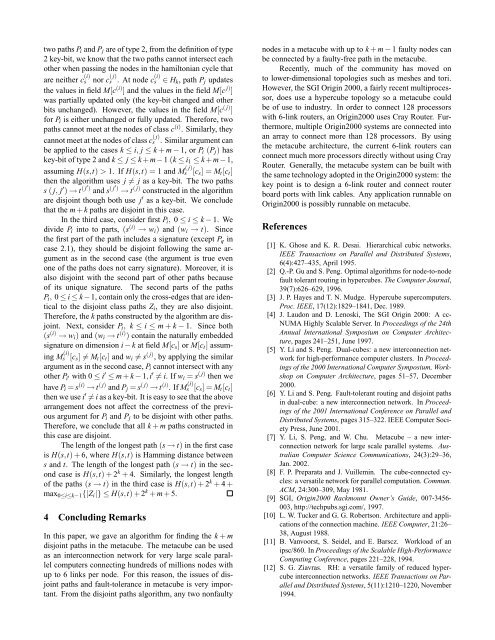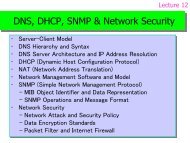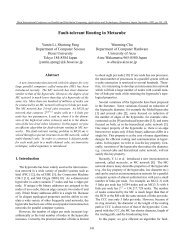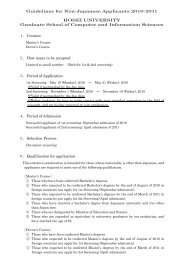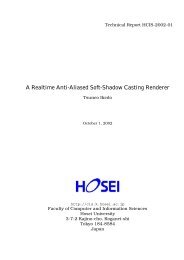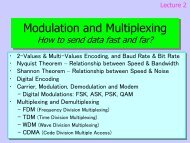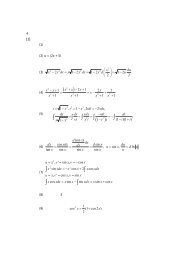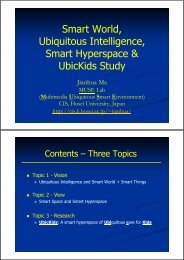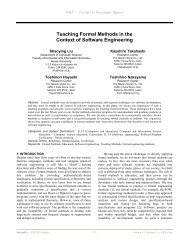Disjoint Paths in Metacube - CiteSeerX
Disjoint Paths in Metacube - CiteSeerX
Disjoint Paths in Metacube - CiteSeerX
You also want an ePaper? Increase the reach of your titles
YUMPU automatically turns print PDFs into web optimized ePapers that Google loves.
two paths P i and P j are of type 2, from the def<strong>in</strong>ition of type2 key-bit, we know that the two paths cannot <strong>in</strong>tersect eachother when pass<strong>in</strong>g the nodes <strong>in</strong> the hamiltonian cycle thatare neither c (i) . At node c (i) ∈ H k , path P j updatess nor c ( sj)sthe values <strong>in</strong> field M[c (i) ] and the values <strong>in</strong> the field M[c j) ]was partially updated only (the key-bit changed and otherbits unchanged). However, the values <strong>in</strong> the field M[c ( j) ]for P i is either unchanged or fully updated. Therefore, twopaths cannot meet at the nodes of class c (i) . Similarly, theycannot meet at the nodes of class c ( sj) . Similar argument canbe applied to the cases k ≤ i, j ≤ k + m − 1, or P i (P j ) haskey-bit of type 2 and k ≤ j ≤ k +m−1 (k ≤ i 1 ≤ k +m−1,assum<strong>in</strong>g H(s,t) > 1. If H(s,t) = 1 and M s ( j) [c s ] = M t [c t ]then the algorithm uses j ≠ j as a key-bit. The two pathss ( j, j ′ ) → t ( j′) and s ( j′) → t ( j) constructed <strong>in</strong> the algorithmare disjo<strong>in</strong>t though both use j ′ as a key-bit. We concludethat the m + k paths are disjo<strong>in</strong>t <strong>in</strong> this case.In the third case, consider first P i , 0 ≤ i ≤ k − 1. Wedivide P i <strong>in</strong>to to parts, (s (i) → w i ) and (w i → t). S<strong>in</strong>cethe first part of the path <strong>in</strong>cludes a signature (except P q <strong>in</strong>case 2.1), they should be disjo<strong>in</strong>t follow<strong>in</strong>g the same argumentas <strong>in</strong> the second case (the argument is true evenone of the paths does not carry signature). Moreover, it isalso disjo<strong>in</strong>t with the second part of other paths becauseof its unique signature. The second parts of the pathsP i , 0 ≤ i ≤ k−1, conta<strong>in</strong> only the cross-edges that are identicalto the disjo<strong>in</strong>t class paths Z i , they are also disjo<strong>in</strong>t.Therefore, the k paths constructed by the algorithm are disjo<strong>in</strong>t.Next, consider P i , k ≤ i ≤ m + k − 1. S<strong>in</strong>ce both(s (i) → w i ) and (w i → t (i) ) conta<strong>in</strong> the naturally embeddedsignature on dimension i − k at field M[c s ] or M[c t ] assum<strong>in</strong>gM s(i) [c s ] ≠ M t [c t ] and w i ≠ s ( j) , by apply<strong>in</strong>g the similarargument as <strong>in</strong> the second case, P i cannot <strong>in</strong>tersect with anyother P i ′ with 0 ≤ i ′ ≤ m + k − 1,i ′ ≠ i. If w i = s ( j) then wehave P i = s (i) → t ( j) and P j = s ( j) → t (i) . If M (i)s [c s ] = M t [c t ]then we use i ′ ≠ i as a key-bit. It is easy to see that the abovearrangement does not affect the correctness of the previousargument for P i and P j to be disjo<strong>in</strong>t with other paths.Therefore, we conclude that all k + m paths constructed <strong>in</strong>this case are disjo<strong>in</strong>t.The length of the longest path (s → t) <strong>in</strong> the first caseis H(s,t) + 6, where H(s,t) is Hamm<strong>in</strong>g distance betweens and t. The length of the longest path (s → t) <strong>in</strong> the secondcase is H(s,t) + 2 k + 4. Similarly, the longest lengthof the paths (s → t) <strong>in</strong> the third case is H(s,t) + 2 k + 4 +max 0≤i≤k−1 {|Z i |} ≤ H(s,t) + 2 k + m + 5.4 Conclud<strong>in</strong>g RemarksIn this paper, we gave an algorithm for f<strong>in</strong>d<strong>in</strong>g the k + mdisjo<strong>in</strong>t paths <strong>in</strong> the metacube. The metacube can be usedas an <strong>in</strong>terconnection network for very large scale parallelcomputers connect<strong>in</strong>g hundreds of millions nodes withup to 6 l<strong>in</strong>ks per node. For this reason, the issues of disjo<strong>in</strong>tpaths and fault-tolerance <strong>in</strong> metacube is very important.From the disjo<strong>in</strong>t paths algorithm, any two nonfaultynodes <strong>in</strong> a metacube with up to k + m − 1 faulty nodes canbe connected by a faulty-free path <strong>in</strong> the metacube.Recently, much of the community has moved onto lower-dimensional topologies such as meshes and tori.However, the SGI Orig<strong>in</strong> 2000, a fairly recent multiprocessor,does use a hypercube topology so a metacube couldbe of use to <strong>in</strong>dustry. In order to connect 128 processorswith 6-l<strong>in</strong>k routers, an Orig<strong>in</strong>2000 uses Cray Router. Furthermore,multiple Orig<strong>in</strong>2000 systems are connected <strong>in</strong>toan array to connect more than 128 processors. By us<strong>in</strong>gthe metacube architecture, the current 6-l<strong>in</strong>k routers canconnect much more processors directly without us<strong>in</strong>g CrayRouter. Generally, the metacube system can be built withthe same technology adopted <strong>in</strong> the Orig<strong>in</strong>2000 system: thekey po<strong>in</strong>t is to design a 6-l<strong>in</strong>k router and connect routerboard ports with l<strong>in</strong>k cables. Any application runnable onOrig<strong>in</strong>2000 is possibly runnable on metacube.References[1] K. Ghose and K. R. Desai. Hierarchical cubic networks.IEEE Transactions on Parallel and Distributed Systems,6(4):427–435, April 1995.[2] Q.-P. Gu and S. Peng. Optimal algorithms for node-to-nodefault tolerant rout<strong>in</strong>g <strong>in</strong> hypercubes. The Computer Journal,39(7):626–629, 1996.[3] J. P. Hayes and T. N. Mudge. Hypercube supercomputers.Proc. IEEE, 17(12):1829–1841, Dec. 1989.[4] J. Laudon and D. Lenoski, The SGI Orig<strong>in</strong> 2000: A cc-NUMA Highly Scalable Server. In Proceed<strong>in</strong>gs of the 24thAnnual International Symposium on Computer Architecture,pages 241–251, June 1997.[5] Y. Li and S. Peng. Dual-cubes: a new <strong>in</strong>terconnection networkfor high-performance computer clusters. In Proceed<strong>in</strong>gsof the 2000 International Computer Symposium, Workshopon Computer Architecture, pages 51–57, December2000.[6] Y. Li and S. Peng. Fault-tolerant rout<strong>in</strong>g and disjo<strong>in</strong>t paths<strong>in</strong> dual-cube: a new <strong>in</strong>terconnection network. In Proceed<strong>in</strong>gsof the 2001 International Conference on Parallel andDistributed Systems, pages 315–322. IEEE Computer SocietyPress, June 2001.[7] Y. Li, S. Peng, and W. Chu. <strong>Metacube</strong> – a new <strong>in</strong>terconnectionnetwork for large scale parallel systems. AustralianComputer Science Communications, 24(3):29–36,Jan. 2002.[8] F. P. Preparata and J. Vuillem<strong>in</strong>. The cube-connected cycles:a versatile network for parallel computation. Commun.ACM, 24:300–309, May 1981.[9] SGI, Orig<strong>in</strong>2000 Rackmount Owner’s Guide, 007-3456-003, http://techpubs.sgi.com/, 1997.[10] L. W. Tucker and G. G. Robertson. Architecture and applicationsof the connection mach<strong>in</strong>e. IEEE Computer, 21:26–38, August 1988.[11] B. Vanvoorst, S. Seidel, and E. Barscz. Workload of anipsc/860. In Proceed<strong>in</strong>gs of the Scalable High-PerformanceComput<strong>in</strong>g Conference, pages 221–228, 1994.[12] S. G. Ziavras. RH: a versatile family of reduced hypercube<strong>in</strong>terconnection networks. IEEE Transactions on Paralleland Distributed Systems, 5(11):1210–1220, November1994.


